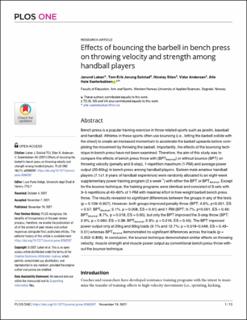| dc.identifier.citation | Løken, J., Solstad, T. E. J., Stien, N., Andersen, V., & Saeterbakken, A. H. (2021). Effects of bouncing the barbell in bench press on throwing velocity and strength among handball players. Plos One, 16(11):e0260297. | en_US |
| dc.description.abstract | Bench press is a popular training-exercise in throw related sports such as javelin, baseball and handball. Athletes in these sports often use bouncing (i.e., letting the barbell collide with the chest) to create an increased momentum to accelerate the barbell upwards before completing the movement by throwing the barbell. Importantly, the effects of the bouncing technique in bench press have not been examined. Therefore, the aim of this study was to compare the effects of bench press throw with (BPTbounce) or without bounce (BPT) on throwing velocity (penalty and 3-step), 1-repetition maximum (1-RM) and average power output (20-60kg) in bench press among handball players. Sixteen male amateur handball players (7.1±1.9 years of handball experience) were randomly allocated to an eight-week supplementary power training program (2 x week-1) with either the BPT or BPTbounce. Except for the bounce technique, the training programs were identical and consisted of 3 sets with 3–5 repetitions at 40–60% of 1-RM with maximal effort in free-weight barbell bench press throw. The results revealed no significant differences between the groups in any of the tests (p = 0.109–0.957). However, both groups improved penalty throw (BPT; 4.6%, p<0.001, ES = 0.57; BPTbounce; 5.1%, p = 0.008, ES = 0.91) and 1-RM (BPT; 9.7%, p<0.001, ES = 0.49; BPTbounce; 8.7%, p = 0.018, ES = 0.60), but only the BPT improved the 3-step throw (BPT; 2.9%, p = 0.060, ES = 0.38; BPTbounce; 2.3%, p = 0.216, ES = 0.40). The BPT improved power output only at 20kg and 30kg loads (9.1% and 12.7%; p = 0.018–0.048, ES = 0.43–0.51) whereas BPTbounce demonstrated no significant differences across the loads (p = 0.252–0.806). In conclusion, the bounce technique demonstrated similar effects on throwing velocity, muscle strength and muscle power output as conventional bench press throw without the bounce technique. | en_US |

